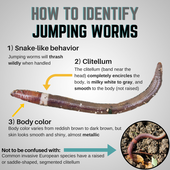Plants, animals, and pathogens adapt over long periods of time to survive their surrounding habitat. When human interaction results in the introduction of these organisms into new habitats, they become known as non-native or introduced. Introduced species do not always have a negative impact on native habitat; in some cases, they can be beneficial to an ecosystem. But when they exploit the lack of natural predators and competitors in a habitat, it can be disastrous. Non-native species that negatively affect our environment, economy or health are known as invasive.
Invasive plants can create a landscape lacking of biodiversity which lowers the efficiency of many ecological processes important for our natural resources. In order to prioritize the control of these invasive species, the Wisconsin DNR has categorized the invasive plants discovered in the state under a "Prohibited" or "Restricted" status. Prohibited plants are invasive species that are not yet established in the state but have the potential to spread if not controlled quickly. Restricted plants are invasive species that are already established in parts or throughout Wisconsin and should be controlled if possible. In order to protect the state of Wisconsin’s natural resources and native wildlife, it is essential we work together to stop the spread of invasive species.
Invasive plants can create a landscape lacking of biodiversity which lowers the efficiency of many ecological processes important for our natural resources. In order to prioritize the control of these invasive species, the Wisconsin DNR has categorized the invasive plants discovered in the state under a "Prohibited" or "Restricted" status. Prohibited plants are invasive species that are not yet established in the state but have the potential to spread if not controlled quickly. Restricted plants are invasive species that are already established in parts or throughout Wisconsin and should be controlled if possible. In order to protect the state of Wisconsin’s natural resources and native wildlife, it is essential we work together to stop the spread of invasive species.
Oh, No,
|
Regulated Plants in the Oneida County Area
Prohibited
|
Amur honeysuckle (Lonicera maackii)
Asian bittersweet (Celastrus Loeseneri) Bohemian knotweed (Fallopia bohemicum) Colt's foot (Tussilago farfara) Common barberry (Berberis vulgaris) Giant hogweed (Heracleum mantagazzianum) Giant knotweed (Fallopia sachalinensis) |
Japanese hedgeparsley (Torilis japonica)
Phragmites (Phragmites australis) Poison hemlock (Conium maculatum) Spreading hedgeparsley (Torilis arvensis) Tall manna grass (Glyceria maxima) Wild chervil (Anthriscus sylvestris) |
Restricted
|
Autumn olive (Elaeagnus umbellata)
Bell's honeysuckle (Lonicera x bella) Bishop's goutweed (Aegopodium podagraria) Black locust (Robinia pseudoacacia) Brown knapweed (Centaurea jacea) Burning bush (Euonymus alatus) Canada thistle (Cirsium arvense) Common buckthorn (Rhamnus cathartica) Creeping bellflower (Campanula rapunculoides) Crown vetch (Coronilla varia) Cut-leaved teasel (Dipsacus laciniatus) Cypress spurge (Euphorbia cyparissias) Dalmatian toadflax (Linaria dalmatica) Dame's rocket (Hesperis matronalis) European marsh thistle (Cirsium palustre) Garden heliotrope (Valeriana officinalis) Garlic mustard (Allaria petiola) Glossy buckthorn (Rhamnus frangula) Hemp nettle (Galeopsis tetrahit) Hound's tongue (Cynoglossum officinale) Japanese barberry (Berberis thunbergii) |
Japanese knotweed (Fallopia japonica)
Leafy spurge (Euphorbia esula) Morrow's honeysuckle (Lonicera morrowii) Narrow-leaf cattail (Typha angustifolia) Oriental bittersweet (Celastrus orbiculatus) Plumeless thistle (Carduus acanthoides) Purple loosestrife (Lythrum salicaria) Rose acacia (Robinia hispida) Scarlet pimpernel (Pimpinella saxifraga) Siberian peashrub (Caragana arborescens) Spotted knapweed (Centaurea stoebe) Tansy (Tanacetum vulgare) Tartarian honeysuckle (Lonicera tatarica) White bedstraw (Galium mollugo) Whitemulberry (Morus alba) White poplar (Populus alba) Wild parsnip (Pastinaca sativa) Woodland forget me not (Myosotis sylvatica) Wormwood (Artemisia absinthium) Yellow iris (Iris pseudacorus) |
Other Regulated Invasive Organisms
Prohibited
|
Asian gypsy moth (Lymantria dispar)
Asian longhorned beetle (Anoplophora glabripennis) Hemlock woolly adelgid (Adelges tsugae) Mountain pine beetle (Dendroctonus ponderosae) Sudden oak death pathogen (Phyophthora ramorum) Thousand cankers disease of walnut (Geosmithia morbidia) Walnut twig beetle (Pityophthorus juglandis) |





